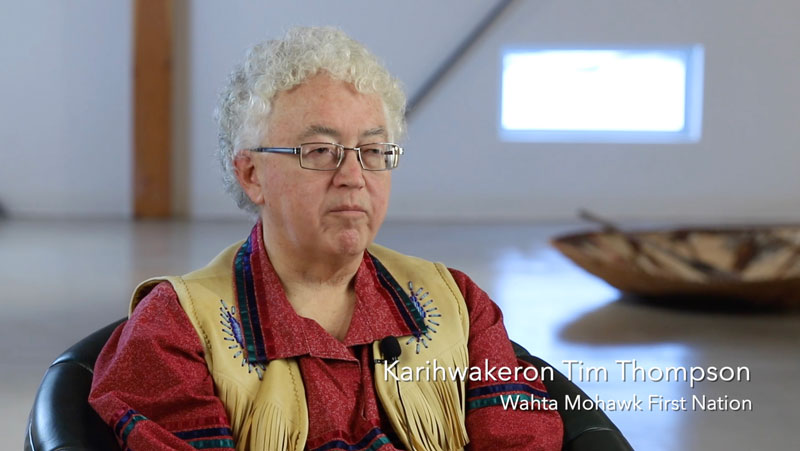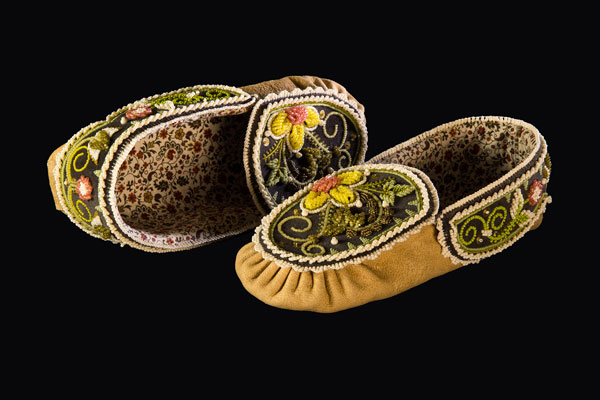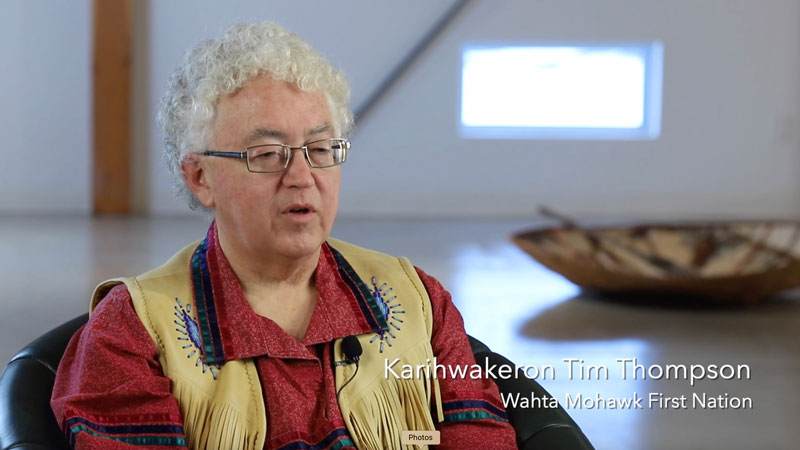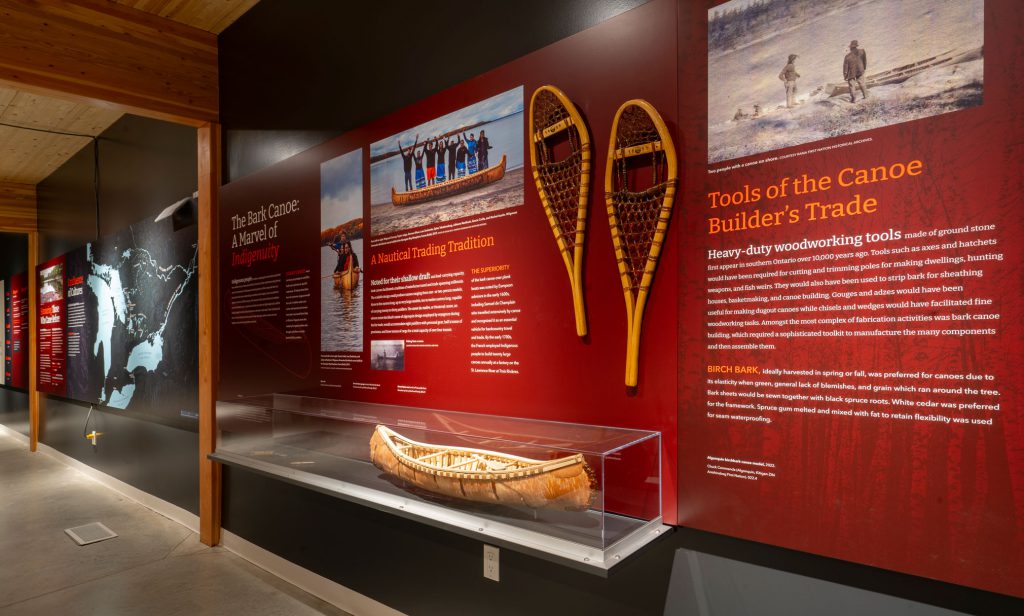Early Wahta tent camp. We do not know the date of this early photo of a Wahta Mohawk encampment but it shows how the families survived the first few years after reaching their lands in Misko-Aki. Courtesy Roy Rennie Photo Collection.
SIXTH LANDING
Arrival of the Wahta Mohawks
What You’ll Learn in this Section
The Haudenosaunee (People of the Longhouse) – Mohawk, Oneida, Onondaga, Cayuga, Seneca, and Tuscarora Nations – have a long history of travelling through and hunting in the Misko-Aki region. In the 17th century, they had several villages along the north shore of Lake Ontario. In 1881, several dozen Mohawk families trekked from their home community of Kanesatake in southwestern Québec into the woods of Misko-Aki. Fleeing persecution from the Sulpician missionaries, they picked this region, the place of sugar maples that they called Wahta, as the place to begin their new lives.
Every Indigenous Nation has uniquely designed artwork, and Mohawk artwork commonly features the use of raised beads to emphasize the shape of leaves, flowers, and animals, made by sewing rows of beads to overlap other beads. Colour is also used to create an illusion of depth.
Mohawk/Haudenosaunee art includes beautiful beaded moccasins, dresses, and intricate baskets to name a few. The Mohawk also excelled at making snowshoes, with much the same technique used to make lacrosse sticks.
Snowshoes are an ingenious design as these allow the wearer to walk across deep snow without sinking. Like the bark canoe, snowshoes exhibit the simplicity and elegance of functional design. Snowshoes have made the transition to modern materials, needing very little modification.
Relocation, Broken Promises, Resiliency
The Haudenosaunee (People of the Longhouse) include the Mohawk, Oneida, Onondaga, Cayuga, Seneca, and Tuscarora Nations. They have a long history of travelling through and hunting in the Misko-Aki region. In the seventeenth century, they had several villages along the north shore of Lake Ontario and were culturally affiliated with the original inhabitants, the Huron-Wendat. In the nineteenth century, some Mohawks returned to Misko-Aki to settle in what is now known as Wahta (“sugar maple”). Their story is a dramatic example of facing adversity, struggling to meet the challenges, and ultimately thriving in this beautiful place.
Chief Joseph Onasakenrat led the fight against the oppression from the Sulpicians and Oka and helped to secure the land in Misko-Aki for the Mohawks who arrived in 1881. He holds a wampum belt that was given to Mohawks, Nippisings, and Algonkians who established the community of Kanehsatà:ke in 1717. To Chief Onasakenrat, this wampum belt proved their ownership of the title to their lands.
COURTESY RICK HILL COLLECTION

Leaving Kanesatake
(Lake of Two Mountains, a.k.a. Oka)
In October 1881, several dozen Mohawk families comprising 70 adults and 63 children, led by Chiefs Joseph Onesakenrat and Louis Sahanatien, travelled from their home community of Kanesatake in southwestern Québec, to the woods of Misko-Aki. Fleeing persecution from the Sulpician missionaries, they picked this region, the place of sugar maples that they called Wahta, as the place to begin their new lives. It was a difficult transition.
“Goodbyes were said amid tears and embraces. The singers in the boat gathered at the foredeck of the steamer and started to sing their farewell song in Indian – a song composed especially for the occasion. Some of the choir could not sing, the sadness of the words choked their voices.”
– Charles A. Cooke, Mohawk scholar, was among those that relocated from Oka to Wahta and recalled his journey
Mohawks Arrive in Misko-Aki
First the Mohawk families, with all their possessions in tow, took a ten-day steamer voyage; then travelled by barge to St. Annes; then by train to Gravenhurst. Along the way, a baby girl named Watahi:ne was born. Then, a second steamboat to Bala, another raft ride, and then the final stretch was an overland hike of about two miles to where their land allotments were found.
“[Grandmother walked when the] snow was 2 feet deep and she had her long dress on and it was frozen from her ankles up to her knees and she was carrying a baby.”
– Wahta elder, Wahta Hydro Oral History Project Report, n.d.

Broken Promises
The Mohawks arrived to find that the homes that the government and the Sulpicians had promised were not built. The first night a heavy snow fell. Unprepared for such weather, people had to scramble to protect themselves from the cold. Women were reported to have cut old blankets into long strips to wrap the feet of the children. They were forced to spend the first winter in tents. It was a deadly winter as six of their children and a few adults died from typhoid fever. Within two weeks, they began to run out of provisions. Many were surprised to find that white squatters had already moved onto their land, cleared homesteads, and erected homes and barns. It took a while for the government to remove the squatters. Some Mohawks moved into the squatter-made homes.
“What are we to do, strangers in a new place – our shanties not in a condition to go into – our provisions very low and about two thirds of our number have not enough money to buy even a day’s provisions. . . What are we to do?”
– Wahta Chief Louis Sahanatien to Indian Agent, November 15, 1881
Carving Out a Home
The Mohawks arrived too late in the season to get promised jobs at the nearby lumber camps. In March 1882, the federal government cut off all aid and encouraged them “to earn their own livelihood and become self sustaining in the future.” They tried to create wilderness gardens, but flooding caused by the local lumber companies wiped out their crops for two years in a row. There were no roads to the settlement, so it was difficult to obtain goods and materials for building houses. People were starving. By August 1882, 22 families had had enough and left Wahta for Kanesatake, Akwesasne, Tyendinaga, or Kahnawake. The Mohawks who remained persisted and eventually their farms prospered. They also found employment in the timber industries and in the growing tourism operations. Yet, they never lost their Mohawk identity or their ability to live in harmony with the land.
Isaiah Dewasha (kneeling in photo), guided people throughout the region. Wahtaronon depended on fish and wild meat for survival. COURTESY KARIHWAKERON TIM THOMPSON.
Misko-Aki in 1881
There was a controversial surrender of Anishinaabek lands in Misko-Aki in the Robinson-Huron Treaty of 1850. When the Mohawks arrived in 1881, Misko-Aki was inhabited by Anishinaabek people on Georgina Island, Parry Island, Shawanaga, Henvey Inlet, Dokis, Nipissing, Temogamingue, and the Chippewas of Rama. Non-Indigenous populations increased after the building of the Colonization Road in 1859 and with increasing steamship lines. Most of the settlers acquired their land (up to 100 acres) through the Free Grants and Homestead Act of 1868. Local towns included Bala and Gravenhurst. Logging was the main industry, employing more than half of the non-Indigenous population in 1881. The leather tanning industry was the second major employer.
Left: Wahta Mohawk people participated in the logging industry, both within the territory and in the Muskoka region. Horses were used in the early days to drag logs to sawmills and river drives. Centre: This photo recalls early encampments erected by the Mohawks when they first arrived in Misko-Aki. At the Indian River Reserve in Port Carling, Wahtaronon sold crafts such as baskets, beaded jewellery, and leather goods. Right: Many Mohawk men used their canoe skills in the local tourist trade, guiding both sports fishermen and vacationers. Robert Stock (crouching in photo) guided people throughout the region. He was a veteran of World War I and World War II and also served his community as an elected game warden and as an elected Chief. COURTESY KARIHWAKERON TIM THOMPSON.
Red Berries That Float on Water
In 1969, the Wahta Mohawks created the Iroquois Cranberry Growers business, which operated successfully for many years. The natural wet bogs of the region were ideal for growing cranberries, which were then turned into juice, jellies, and various foods. The berries are picked in the fall and float on the water until they are gathered. To the Mohawk, cranberries were also a medicine plant. It became the largest cranberry operation in Ontario with 68 acres of floating gardens. By the mid-1990s, too much competition drove down prices and the cranberry operation was closed in 2017.
While the Mohawks were able to eke out vegetables from the rocky soil, they also diversified their economy and turned to the growing timber industry. When they first moved here, the province prohibited them from cutting soft wood trees trying to save the economic benefits for the local whites. Logging became a major industry in the Muskoka region and led to the transformation of the landscape.

Tsi Tewaienthótha
is a community organization dedicated to re-strengthening food security, community resilience, and Kanien’kehá:ka (Mohawk) culture and traditions in Wahta through communal engagement in life-affirming food production techniques, food preparation, and healthy and culturally appropriate eating.

LISTEN TO OUR STORIES
Karihwakeron Tim Thompson, Wahta Mohawk Territory, explains the history of Haudenosaunee people in this region. (Length: 2:00)
ICONIC OBJECTS GALLERY
Explore objects that reflect Misko-Aki’s ancient Indigenous history.


LISTEN TO OUR STORIES
Karihwakeron Tim Thompson, Wahta Mohawk Territory, talks about relations between the Haudenosaunee and European colonists. (Length: 2:00)

7 GRANDFATHER TEACHINGS
HUMILITY
The Mohawks who established Wahta went through incredible hardship in seeking a place of freedom. This required two important character traits: perseverance and humility. They struggled to make homesteads, they struggled to harvest a livelihood from the land. Their faith sustained them. They carried the ancient value of humility forward, being thankful for what the land provided and working to the best of their abilities to provide for their families and build a viable community.
In Mohawk: Iah teiakotatsennakarátaton (one doesn’t raise up their own name)

Are You Ready to Experience Misko-Aki in Person?
Visit the Muskoka Discovery Centre to explore Misko-Aki as well as our many other immersive exhibits, programs and activites.
Purchase Tickets






